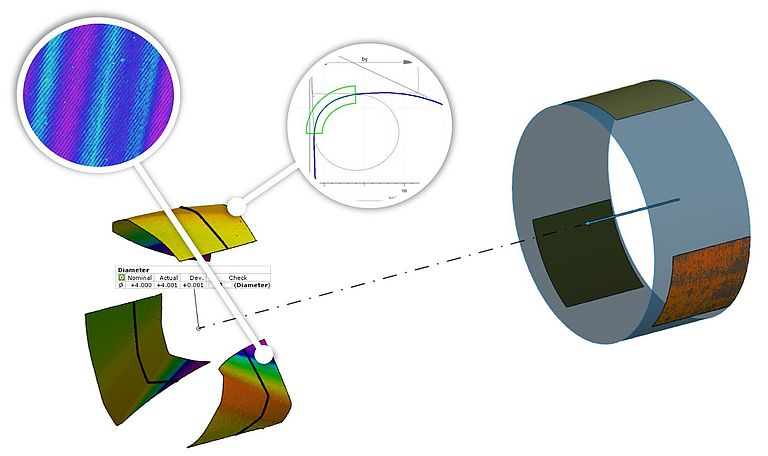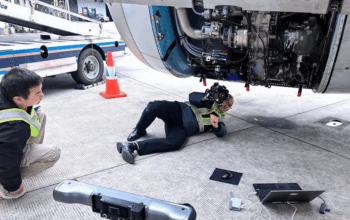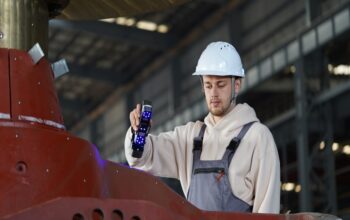Based on the technology of focus variation, the optical coordinate measuring system µCMM combines advantages of tactile coordinate measuring technology and non-contact surface measurement. Complex component geometries with the smallest tolerances are easily accessible and can be measured with the highest accuracy using only one sensor.
#1 WHAT IS SO SPECIAL ABOUT THIS CMM MACHINE?
µCMM is the 1st optical coordinate measuring system that enables the measurement of dimension, position, shape, and roughness with the highest accuracy using just one sensor. µCMM offers high accuracy over the entire measuring volume 310 x 310 x 310 mm including high measuring point density, which, in addition to dimensional metrology also achieves roughness measurement according to ISO 4287/88 (Ra, Rq, Rz…) and ISO 25178 (Sa, Sq, Sz…). No other available tactile or multi-sensor coordinate measuring system can measure both the shape and roughness of components with just one sensor.
#2 HOW ACCURATE IS CMM?
The length measuring deviation remains below E=(0.8+L/600) µm in the entire measuring volume and conforms to ISO 10360. The high measuring point density, even over longer distances, enables the measurement of the smallest component tolerances and the precise determination of the position of these individual measurements in relation to each other. This means that it is no longer necessary to measure the entire component optically. Only those surface details that are relevant need to be measured. This speeds up overall measurement times.

#3 HOW CAN THE ACCURACY OF THE CMM MACHINE BE VERIFIED?
Two calibration standards verify the accuracy of the µCMM coordinate measuring system. The µCMM CalibrationTool, made of Invar steel and calibrated by DAkkS (Germany), is designed to measure and verify larger distances. It shows calibrated sphere distances of (mm) 10, 50, 100, 200, 300, 400. The Advanced µCMM CalibrationTool, calibrated by METAS (Switzerland), is used to verify smaller distances and shape deviations.

#4 HOW EASY IS CMM TO USE?
µCMM offers simple, intuitive operation, even for several users, e.g. in a production environment. The control runs i.e. via a specially developed ergonomic controller with a multi-touch screen. Depending on the task, only the information necessary for the operator is displayed. When teaching-in a measuring task, this is the measurement field; when changing objective lenses, it is the available lenses. In addition, different speed modes allow either fast rough positioning or focusing on the component detail to be measured.

#5 DOES CMM OFFER AN AUTOMATIC CHANGE OF OBJECTIVE LENSES?
Yes. µCMM includes an automatic objective lens changer rack, which has several advantages over conventional coordinate measuring machines. Stationary magazines, as they are usually used in tactile CMMs or multi-sensor measuring systems, reduce the usable measuring volume. With the µCMM optical coordinate measuring system, the usable measuring volume is identical to the travel volume.

#6 WHICH SURFACES AND MATERIALS CAN BE MEASURED WITH THE OPTICAL CMM MACHINE?
Thanks to the “SmartFlash” illumination technology, the µCMM is suitable for matt to smooth, highly polished components. The core of SmartFlash is the modulated illumination during the vertical scanning process. Each individual measuring point is optimally illuminated in order to obtain robust and high-resolution 3D depth data. This means that surface defects can also be measured on smooth surfaces, i.e. glass, below0.01µm.

#7 WHAT HARDWARE COMPONENTS ARE USED?
The XYZ axes use market-leading Zerodur Heidenhain scales with a resolution of 3.9 nm. The accuracy of the axes in combination with the solid granite construction and active temperature compensation also enables use in production. In addition, the stability of the measuring system is increased by the air-bearing axes with the wear-free drive (linear drive). µCMM can be extended from 3 to 5 axes by means of an automatic rotation and tilt unit.
#8 WHAT ARE THE ADVANTAGES OF EXTENDING THE CMM TO A 5-AXES SYSTEM?
An automatic rotation and tilt unit “Advanced Real3D Rotation Unit” extends the 3-axes system by a 4th and 5th axis. This opens up automation options for measurements without re-clamping. Also, it increases accessibility to measuring positions on complex components. The rotation unit can be equipped with three-jaw, 3R, or Erowa clamping systems.

#9 DOES CMM ALLOW FULL MEASUREMENT AUTOMATION?
Yes, in combination with the Automation Manager automation interface µCMM enables the complete automatic measurement and evaluation of components. Measurement programs for both roughness measurement and form measurement can be automated quickly and easily. An administrator defines the necessary measuring programs which are started by a worker (as of example in production) at the push of a button. The selection of the programs to be measured is done via a dropdown menu or a barcode scanner. Further interfaces such as CAD-CAM connection enable networking and communication with existing production and quality management systems according to the Smart Manufacturing production concept.
#10 CAN THE CMM COORDINATE MEASURING MACHINE ALSO PROBE SIDEWAYS, E.G. TO MEASURE HOLES?
Yes, thanks to µCMM it is for the first time possible to measure holes optically. The measurement is based on the use of the complete light cone. This causes individual light beams to be reflected even by vertical surfaces and captured by an objective lens. This means that flanks with more than 90° are traceably measured in high accuracy and repeatability. The maximum ratio of diameter to depth ranges from 1:3 to 1:10 mm. For complex components such as injection valves, the orientation of the individual holes to each other is also measured in combination with Real3D.

To know more, check Bruker Alicona.









